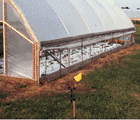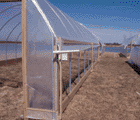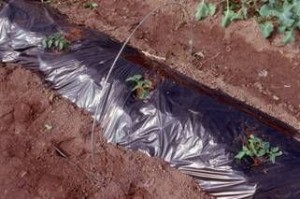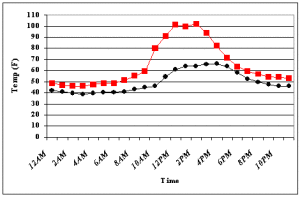I. What is a high tunnel?
A high tunnel is a solar heated, manually vented, plastic-covered cold frame that is used to lengthen the traditional growing season for many horticulture crops. High tunnels, often called hoophouses can significantly increase the average daily temperature and protect the crop from wind, rain, snow, hail, insects and diseases. High tunnels are not greenhouses, and thus require no electrical connections for ventilation and supplemental heat. A single or double layer of plastic can be attached to bows spaced 4-6 feet apart. The crop is grown directly in the soil using raised beds or mulch depending on the type of vegetable. Drip irrigation is essential for providing water and nutrients to the crop during the growing season. Most high tunnels have roll-up sidewalls and detachable endwalls for temperature and humidity management.



Figure 1. University of Missouri high tunnels, Columbia, MO. Each high tunnel is 20’width x 9-14’height x 36’ length. Roll-up sidewalls and detachable end walls provide ventilation and temperature control.
Many vegetable crops can be successfully grown within a high tunnel. Tomatoes are particularly well adapted to culture within a high tunnel since tomatoes can be trained to grow vertically by trellising or staking. Early season tomatoes also reward growers with premium prices since it is difficult to consistently harvest field tomatoes before July in the central Great Plains.
Production Inputs for High Tunnel Tomatoes

Figure 2. Raised bed with black plastic mulch (1 mil, embossed). Drip tape is placed under the plastic mulch.
A permanent high tunnel should be placed on fertile, non-shaded, well-drained soils with a pH in the range of 6.0-7.0. Since high tunnels are manually vented, they should be placed in an accessible location. The soil should be tilled to a depth of approximately 6-8 inches, and nutrients applied based on a recent soil test. Tomatoes should be established on a raised bed.
Raised beds will significantly enhance soil warming, drainage and volume of soil for rooting. An ideal raised bed should be about 8-10” high with 30-36” width at the top. Typically, a 20’ x 96’ high tunnel will accommodate five rows of tomatoes. Raised beds can be made with power tillers or compact bed shapers. After the raised beds are formed, fertilizer, drip tape and plastic mulch can be applied (Figure 2).
For early tomato production, black, clear or IRT (infrared transmitting) mulch can be applied to increase soil temperatures, reduce weed emergence and soil evaporation. For maximum effectiveness, black plastic mulch should have good contact between the mulch and the surface of the bed for effective transfer of heat. Embossed plastic mulch will fit tightly over the bed. Clear plastic will increase soil temperatures significantly more than black plastic, but weeds will emerge under the clear film (Table 1). White plastic (white on black or white) will significantly lower soil temperatures and can be used for late summer or fall high tunnel tomato production.
Table 1. Plastic mulch effects on soil temperature
| Mulch Type | Soil Temperature increase (+) or decrease (-) (°F) |
| Black | +5 |
| Clear | +8-14 |
| IRT2 | +5-10 |
| White | -2 |
1Soil temperature at 2″ deep.
2Infrared transmissible
Source: Penn State University Center for Pasticulture and Univeristy of Missouri
Organic mulches such as straw, hay or compost can be used for high tunnel tomatoes. Organic mulches create a favorable environment for many beneficial insects while increasing organic matter. However, some organic mulches (straw or hay) can significantly lower soil temperature and thus would not be effective for warming the soil in the spring. Compost can increase soil temperatures, but not as effectively as black plastic mulch. Organic mulches can be applied when the soil temperatures have increased.
Since the high tunnel excludes natural rainfall, irrigation must be provided. Drip irrigation for tomatoes will significantly improve marketable yield and overall quality. A uniform application of water will reduce fruit cracking and other physiological problems such as blossom end rot. The drip tape (a ¾” small, collapsible tube) should be buried slightly below the soil 2-3” inches to the side of the plant with the drippers on the top. Eight or 10-mil tape is acceptable with drippers spaced 4-12” apart. A drip system operates at 8-15 psi pressure. For a list of regional drip irrigation suppliers, consult the Appendix.
Tomatoes use a large volume of water, particularly during fruit sizing. The fruit is approximately 95% water. From fruit set to harvest, approximately 1½ -2 quarts of water per plant may be needed each day.
One technique to monitor soil moisture is to use a tensiometer. A tensiometer is a device that measures soil moisture tension as centibars (cb). The drier the soil becomes the higher the centibar reading from the tensiometer. Generally, for tomatoes, the soil moisture tension should be maintained between 10 and 20 centibars. When soil moisture tension exceeds 20 centibars, irrigation should occur.
An additional advantage of drip irrigation within a high tunnel is the ability to inject water-soluble nutrients through the drip lines as the plant needs them. Generally, large quantities of phosphorus and potassium should not be applied through the drip system. Rather, based on a recent soil test, all the needed phosphorus and the majority of potassium can be applied at planting or between cropping cycles within a high tunnel. Approximately 40-50% of the total nitrogen requirements for tomatoes can be applied prior to planting, with the balance applied through the drip system over the course of the growing season. Nitrogen requirements for tomatoes depend on the soil quality (i.e., organic matter) and previous cropping history. Generally, for each 1% organic matter content of your soil, you can assume that there are 20 pounds of residual nitrogen per acre. Therefore, if you have organic matter levels greater than 3%, no preplant nitrogen is necessary. However, if your soil organic matter is less than 3%, and you have not been supplementing the soil with organic residues, you should apply the equivalent of 1.4 pounds of actual nitrogen per 1000 square feet (equivalent to 60 pounds of actual nitrogen per acre) at or before transplanting. An additional 8-10 units of nitrogen (per acre equivalent rate) pounds per week can be applied via the drip system starting 2 weeks after transplanting (see Example).
Example: Assume a 20’ x 96’ (1,920 square feet) high tunnel has 5 rows of tomatoes spaced 18”x48”. The total plant population within the high tunnel is 320 plants. Providing 8-10 lbs of actual nitrogen per acre using calcium nitrate (15.5% N) is equivalent to applying 2.2-2.8 lbs of calcium nitrate per week for the high tunnel. This is equivalent to applying 9 oz of calcium nitrate per plant per week.
Row covers are an important component of successful high tunnel tomato production. Row covers are lightweight, spunbonded polypropylene blankets that are supported loosely over the crop row or canopy. In the field environment, a medium-weight (0.5-0.6 oz/yd2) row cover will increase air temperature around the crop by approximately 2-4°F, while protecting the crop from adverse weather and insect injury. Using row covers within a high tunnel can significantly increase the average daily temperature. For early tomato production within a high tunnel, row covers can be 2-3 times more effective relative to their same performance in the field. A medium weight or 2x (double) layer of a light row cover should be placed over the plants after transplanting. Unlike row covers in the field, wind currents do not remove trapped thermal energy under the row cover within a high tunnel, and the row cover acts as an insulating layer over the plant. Another option is the use of low tunnels that act as mini-greenhouses (18-24” high) with a single or double layer of plastic (1 mil). Low tunnels can significantly increase air temperatures, but must be vented to prevent excessively high temperatures. Row covers can be kept on the plants from the time of transplanting (mid to late March) until the appearance of the first flower cluster. At this point, they can be removed and kept in reserve in case temperatures get low at any future time. If the sidewall vents are rolled-up (i.e., ambient temperatures are greater than 60°F) the row covers can be removed at any time. Row covers should be kept on tomato plants if the night temperatures are less than 50°F.
Tomato Plant Characteristics
The tomato is a warm season vegetable crop that is sensitive to frost and will be killed by freezing temperatures. Tomatoes have either a determinate or indeterminate growth habit. Determinate tomato vines produce side shoots that terminate in a flower cluster, and the plant reaches a height of 3-4 feet. Therefore, yield is concentrated over a 4-6 week period. Indeterminate tomatoes continue to produce additional vines and flower clusters throughout the growing season and may reach 5-7 feet in height.
Link:Rutgers Cooperative ExtensionTomato plants do not need a specific day length in order to flower. The flowers are self-pollinated, but physical vibration of the flower either by physically shaking the plant, wind, or insects will facilitate pollination. The optimum temperatures for pollination are 68-75°F (night) and 60-90°F (day). At prolonged temperatures of less than 55°F or greater than 95°F, flowers can drop from the plant. High humidity (greater than 80%) can also adversely affect pollination.
Flowering until harvest is approximately 45 days for most tomato cultivars. Since tomato pollination and fruit quality is linked to temperature and humidity, the high tunnel should be monitored carefully for extreme temperatures.
In early spring, the period of venting is usually between 10AM and 4 PM. If left nonvented, a high tunnel can reach extremely high temperatures (Figure 3). For example, a 60°F day can produce 100°F temperatures within the high tunnel. The level of venting depends on prevailing winds and sunlight intensity. The goal should be to keep daytime temperatures within the range of 75-85°F. In the event of a frost, close the vents in mid-afternoon and place row covers on the plants.
Figure 3. Daily temperature fluctuations within a nonvented (single plastic layer) high tunnel on March 27, 2002 in Columbia, Missouri. Vent is opened around 11:00 am as the temperature reaches 80°F and closed shortly before 6:00 pm.


High Tunnel Tomato Culture
Transplant production: Tomatoes are most commonly established in the high tunnel by transplants. The critical first step in transplant production is to purchase quality seed from a cultivar that possesses characteristics you prefer. One ounce of tomato seed contains 6,000-12,000 seeds. For a list of tomato seed suppliers, consult the Appendix. The optimum germination temperature for tomato seed is 75°F, and the optimum temperature range for growth of the transplant is 60-70°F. Seeds should be sown approximately 5-7 weeks before you anticipate transplanting in a germination flat or 50-72 cell tray. Container size is important for early tomato production. Research has revealed that the container size for tomatoes should be at least 2¼” in diameter. For example, if the seed is sown in a 72-cell tray, the seedlings can be replanted in a 606 Compack ( 2¼” x 2” cell) flat beginning at the 2 true leaf stage. Excessive watering, nitrogen, temperature or low light will cause excessive “leggy” growth. A good tomato transplant should be stocky. Tomato transplants can be conditioned or “hardened off” before transplanting. Hardening of tomato plants enables the plants to survive the shock of transplanting within the high tunnel.

Figure 4. Staking and stringing of tomato plants will improve fruit quality and early marketable yield.
Plants that are not properly hardened off will be slow to start growth after transplanting. Hardening of tomato transplants can be accomplished by taking plants from the greenhouse about 10 days before you anticipate transplanting and exposing them to outside temperatures and wind for a few hours each day ?50°F outside temperature).
Transplanting within a high tunnel: Tomatoes can be planted when soil temperatures reach 60°F at the 2” depth. For early tomato production, row covers, raised beds, drip irrigation, and plastic mulch are essential. You may wish to invest in portable back-up heaters if you feel the risk of a freeze is great within your region. Tomatoes within a high tunnel should occupy approximately 4-6 square feet of land. Earlier cultivars that do not produce a large vine can be spaced closer than mid-season or cultivars that tend to have vigorous vines. Typical spacings are 18-24” apart within row and 36-48” between rows. For example, in a 20’ x 96’ commercial high tunnel, approximately 300 tomato plants can be planted.
Training tomatoes within a high tunnel is very important. When tomatoes are staked, light interception is improved, the plant is more likely to set early fruit and disease tolerance is improved. For a high tunnel, the most appropriate way to train tomatoes for early harvest is the stake and weave system. The stake and weave system entails using a 48-52” x 1” square wooden pine stake (metal rebar is also acceptable) that is driven between every other tomato plant (Figure 4). When the tomato plants reach a height of 12”, the first string can be applied. Nylon plastic twine is the best source of string. Every 6” of new growth will require a new string where the string is providing support for the tomato vine and fruit load. If you choose to trellis tomatoes, make certain your high tunnel frame can support the crop load.

Figure 5. Pruning tomato plants.
Pruning, the removal of suckers or axillary shoots that grow between the leaf and the main stem, will accelerate early harvest and improve disease tolerance by enhancing air circulation around the plant (Figure 5). While pruning may be too labor intensive for field production, tomatoes within a high tunnel should be pruned if the objective is early harvest. Pruning will not increase total marketable yield. The objective of pruning is to achieve a balance between vine and fruit growth. Remove all suckers up to the one below the first flower cluster resulting in two stems per plant. Prune when the suckers are less than 4” long, and do not prune the plants if they are wet. After pruning, you may wish to apply a labeled fungicide to protect against disease outbreak
Variety Selection
The essential first step to successful high tunnel tomato production is selection of a suitable variety (Table2). High tunnel tomato research at the University of Missouri continues to screen tomato varieties within the high tunnel environment. In general, every tomato variety evaluated within a high tunnel has been equal to or better than that variety performance in the field.
Table 2. Some tomato varieties for high tunnel production1.
For more on Tomato Cultivars go to:Part II ARTICLE Evaluating Suitable Tomato Cultivars for Early Season High Tunnel Production in the Central Great Plains
| Variety | Days to harvest | Disease resistance | Comments |
| BHN 543 | 72 | FW12 V1 | Midseason early; Excellent size, shape and quality. |
| Carolina Gold | 75 | FW12 V1 GW | Yellow (tangerine) colored fruit; Vigorous vine. Excellent quality. |
| Florida 47 | 75 | FW12 V1 | Large, smooth, crack-resistant fruit; Good quality; Vine slightly less vigorous than Fl 91. |
| Florida 91 | 72 | FW12 V1 | Large, smooth, crack-resistant fruit. Heat-set variety with good disease tolerance. |
| Floralina | 72 | FW123 V1 | Large, smooth, crack-resistant fruit. Very good taste. |
| Merced | 69 | FW12 V1 | Early; Good quality. Has a tendency to crack in the field but not the high tunnel. |
| Mountain Fresh | 78 | FW12 V1 | Excellent midseason variety; Very good quality. Vigorous vine. Good disease tolerance. |
| Mountain Spring | 70 | FW12 V1 | Early; Excellent fruit size. |
| Sunleaper | 70 | FW12 V1 | Heat-set variety good for summer and fall production. |
| Sunbrite | 70 | FW12 V1 | Compact plant with high yields. |
1This list of tomato varieties is not intended to list every variety that may perform well within a high tunnel.
FW=Fusarium wilt race 1, 2, 3; V=Verticillium wilt race 1; GW=Grey wall.
Table 3. Troubleshooting tomato problems within a high tunnel.
| Problem | Possible Cause | Solution |
| Flowers are falling off plants | Temperatures are either too cold or too warm. | Proper venting for temperature management. |
| Flowers fuse together | Too cool. | Proper temperature management |
| Fruit are catfaced or misshapen | Pollination disorder. | Humidity may be too high or temperature too low. |
| Cupping or rolling of leaves | If the upper leaves experience cupping or rolling, check for aphids. Aphids produce a sticky excrement that attracts flies and ants and is colonized by a dark fungus. | Aphids can be controlled by using registered, labeled organic or synthetic pesticides and releasing beneficial insects. |
| Some early-season cultivars roll or cup their leaves when they have a heavy fruit load. | Genetics | |
| Water stress (excess or deficiency) | Irrigation management. | |
| Poor fruit set | Temperatures are too high or low or humidity is excessive. | Temperature management. Do not keep rowcovers on plants too long. |
| Flowers are not being vibrated enough for pollination. | Roll-up sidewalls if temperature permits. Shake tomato stakes to facilitate pollen release. Use bumblebees. | |
| Fruit has grey mold on the stem end | Grey mold (Botrytis) fungus | Disease that is promoted by high humidity and cool, cloudy weather. Vent high tunnel properly. Use labeled fungicides, and increase air circulation around the fruit. |
| Border rows have fruit with holes. Foliage feeding. | Worm feeding | Bt insecticides should be applied every 14 days commencing at flowering. If worms are visible, you may wish to use another labeled pesticide. |
| Stem lesions causing the plant to wilt. | Disease | Have plants diagnosed by your local extension person. |
| Fruit fails to ripen | Temperature | If picking during hot weather, use a shade cloth. Late fall tomatoes may not ripen because of low light and temperatures. |
| Black spots on bottom of fruit | Blossom end rot | Blossom end rot is caused by a localized deficiency of calcium to the developing fruit. Make sure your soil has medium to high calcium levels; water uniformly; do not apply a lot of NH4 fertilizers or overprune. Calcium can be applied through the drip system. Do not apply foliar calcium. |
| Fruit cracking | Irregular watering | Mulch and water uniformly. |
Resources
View Tomato Seed Suppliers as PDF File
View Drip Irrigation Suppliers as PDF File
About the Author: Lewis Jett is and Assistant Professor & State Vegetable Crops Specialist at Department of Horticulture, University of Missouri-Columbia, Columbia, Missouri 65211-7114.
Download the paper Production of Tomatoes within a High Tunnel



